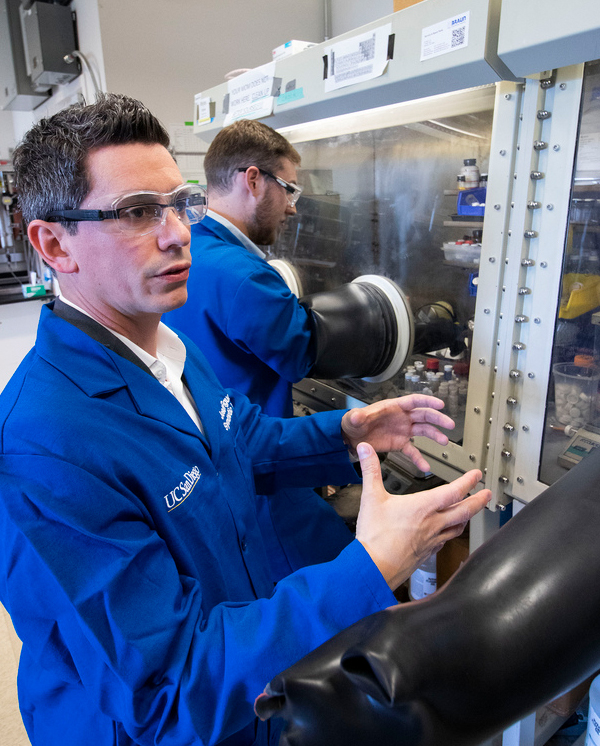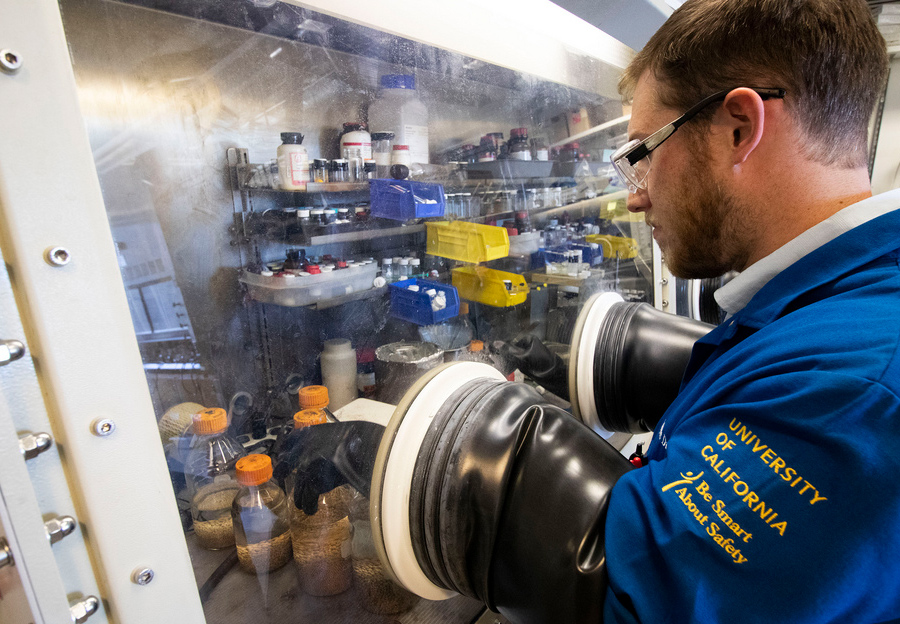
Chemists Cook Up Elusive Molecule for the First Time
UC San Diego researchers verify decades-old predictions about transition-metal complexes
Published Date
By:
- Cynthia Dillon
Share This:
Article Content
In this year designated as the “International Year of the Periodic Table of Chemical Elements,” it is fitting that scientists from UC San Diego have confined a long-contemplated diatomic molecule by isolating a metal compound containing the elusive “BF.”
An unstable cousin to the highly toxic carbon monoxide (CO) and the benignly common dinitrogen (N2), BF—chemically known as boron monoflouride—has only been studied theoretically, computationally or at extremely high temperatures in the gas phase—until now. Research by Professor of Chemistry & Biochemistry Joshua Figueroa and PhD candidate Myles Drance, published recently in Science, provides an experimental investigation of BF bound to a transition metal, iron (Fe). Their work enabled direct comparisons of BF’s properties to its more familiar cousins, producing an achievement in fundamental chemistry which means that BF could be used in place of CO, in certain contexts, to fine-tune chemical catalysts in reactions or to access new chemistry.

Professor Joshua Figueroa (lower left) describes the experiment he and Myles Drance successfully completed. Drance works in the glovebox in the background. Photo by Michelle Fredricks, UC San Diego Physical Sciences
For more than 100 years, inorganic chemists have hypothesized about the interaction of CO and N2 with transition metals. These molecules each have 10 electrons in their outer electronic shell, arising from combinations of 4+6 electrons in the case of CO, and of 5+5 electrons in the case of N2. For decades scientists have only predicted how to generate a molecule with a 3+7 electron combination of light elements, which would have starkly different qualities than either CO or N2.
“BF is too reactive for routine study in a laboratory setting; it’s a gaseous molecule likely found in interstellar space,” explained Figueroa. “But, by placing it on a metal center, we can use it as a reagent to invent new chemistry for it in a controlled environment at room temperature.”
This breakthrough stabilization of BF occurred with the use of ligands—a group of atoms that binds to metal—essentially creating a suit of armor for an iron center, protecting it from further chemical activity. This stabilization allows the highly reactive BF to be built within a secure enclosure, thereby taming it for systematic study.
“This is a fundamental story of bonding in inorganic chemistry and the periodic table in general, but it was an unmet challenge within the field,” said Figueroa. “It is a molecule that is in textbooks, but it had never been observed in stabilized form.”
Drance described the scientific process of stabilizing BF as being similar to creating recipes.
“It’s like baking or cooking—putting things together in new ways,” he explained. “We mix molecules with metals in unusual environments to create the right mix for further discovery.”

PhD candidate Myles Drance at work through the glovebox in the Figueroa Group lab. Photo by Michelle Fredricks, UC San Diego Physical Sciences
The scientists conducted several tests of their BF creation, which involved proving that they had indeed isolated a BF-metal compound and systematic comparisons between BF and CO and N2 to show how these simple molecules differ. The work was carried out in a dinitrogen-filled glovebox to prevent the compounds from decomposing in the presence of oxygen or water. They used X-ray crystallography to determine the structure of the compounds and nuclear magnetic resonance (NMR) spectroscopy to gain additional insight about the bonding occurring within molecules.
“Our characterization studies indicated that we really had it,” said Figueroa. “We had an idea of the synthetic route that could potentially provide a BF complex, but that’s just a dream on paper,” said Figueroa, “Amazingly, in this case it worked.”
The researchers admitted that they were surprised that they were able to synthesize a BF complex, especially since many other scientists have tried unsuccessfully for decades.
“We were not surprised, however, by the results once we had it,” said Figueroa. “All the chemical and spectroscopic properties are almost exactly in line with what was predicted, which is so exciting.”
This research was supported by the U.S. National Science Foundation (Grants CHE-1802646).
Share This:
You May Also Like
Stay in the Know
Keep up with all the latest from UC San Diego. Subscribe to the newsletter today.


